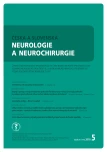Validation of questionnaire for patients with myotonia – Czech version of Myotonia Behaviour Scale
Authors:
M. Horáková; T. Horák; O. Parmová; S. Voháňka
Authors‘ workplace:
Neurologická klinika LF MU a FN Brno
Published in:
Cesk Slov Neurol N 2018; 81(5): 582-585
Category:
Original Paper
doi:
https://doi.org/10.14735/amcsnn2018582
Overview
Background:
Myotonia is a cardinal symptom of myotonic disorders. The most typical symptom of myotonia is a difficulty in releasing a forceful handgrip. It significantly deteriorates the quality of life to a degree that is disabling. Therefore, many drugs have been tested in myotonia therapy. One of the main issues of clinical trials has been the lack of a conclusive method for the quantification of myotonia. The aim of our study was translation and validation of the Myotonia Behaviour Scale (MBS). This scale was designed for subjective assessment of myotonia severity.
Methods:
Czech translation was approved by a professional translator and then validated through forward-backward translation. Repeatability and reproducibility were tested on a sample of 15 patients with myotonic dystrophy type 1 (MD1) and 25 patients with myotonic dystrophy type 2 (MD2). All patients completed one MBS form during a routine visit and a second one two days later.
Results:
The average MBS score was 2.5 in MD1 group and 1.7 in MD2 group. Correlation coefficients between the first and second completion were 0.965 in MD1 and 0.991 in the MD2 group, respectively. Correlation coefficients between relaxation time of handgrip and MBS score were 0.672 in MD1 and 0.627 in the MD2 group, respectively.
Conclusion:
MBS is a simple and quick scale suitable for long-term monitoring of patients with myotonia. We reported a significant correlation between MBS score and relaxation time of a forceful handgrip in both groups.
Key words:
myotonic dystrophy – myotonia – scale – questionnaire
The authors declare they have no potential conflicts of interest concerning drugs, products, or services used in the study.
The Editorial Board declares that the manuscript met the ICMJE “uniform requirements” for biomedical papers
Sources
1. Peric S, Heatwole C, Durovic E et al. Prospective measurement of quality of life in myotonic dystrophy type 1. Acta Neurol Scand 2017; 136(6): 694 – 697. doi: 10.1111/ ane.12788.
2. Wolf A. Quinine: an effective form of treatment for myotonia: preliminary report of four cases. Arch Neurol Psychiatry 1936; 36(2): 382 – 383. doi: 10.1001/ archneurpsyc.1936.02260080154011.
3. Trip J, Drost G, van Engelen BG et al. Drug treatment for myotonia. Cochrane Database Syst Rev 2006; 1: CD004762. doi: 10.1002/ 14651858.CD004762.pub2.
4. Andersen G, Hedermann G, Witting N et al. The antimyotonic effect of lamotrigine in non-dystrophic myotonias: a double-blind randomized study. Brain 2017; 140(9): 2295 – 2305. doi: 10.1093/ brain/ awx192.
5. Hammarén E, Kjellby-Wendt G, Lindberg C. Quantification of mobility impairment and self-assessment of stiffness in patients with myotonia congenita by the physiotherapist. Neuromuscul Disord 2005; 15(9): 610 – 617. doi: 10.1016/ j.nmd.2005.07.002.
6. Budzynski TH, Stoyva JM, Adler CS et al. EMG biofeedback and tension headache: a controlled outcome study. Psychosom Med 1973; 35(6): 484 – 496.
7. Brook JD, McCurrach ME, Harley HG et al. Molecular basis of myotonic dystrophy: expansion of a trinucleotide (CTG) repeat at the 3’ end of a transcript encoding a protein kinase family member. Cell 1992; 69(2): 385.
8. Liquori CL, Ricker K, Moseley ML et al. Myotonic dystrophy type 2 caused by a CCTG expansion in intron 1 of ZNF9. Science 2001; 293(5531): 864 – 867. doi: 10.1126/ science.1062125.
9. Mankodi A, Takahashi MP, Jiang H et al. Expanded CUG repeats trigger aberrant splicing of ClC-1 chloride channel pre-mRNA and hyperexcitability of skeletal muscle in myotonic dystrophy. Mol Cell 2002; 10(1): 35 – 44.
10. Charlet BN, Savkur RS, Singh G. Loss of the muscle-specific chloride channel in type 1 myotonic dystrophy due to misregulated alternative splicing. Mol Cell 2002; 10(1): 45 – 53.
11. Bernareggi A, Furling D, Mouly V et al. Myocytes from congenital myotonic dystrophy display abnormal Na+ channel activities. Muscle Nerve 2005; 31(4): 506 – 509. doi: 10.1002/ mus.20235.
Labels
Paediatric neurology Neurosurgery NeurologyArticle was published in
Czech and Slovak Neurology and Neurosurgery

2018 Issue 5
- Metamizole at a Glance and in Practice – Effective Non-Opioid Analgesic for All Ages
- Memantine in Dementia Therapy – Current Findings and Possible Future Applications
- Advances in the Treatment of Myasthenia Gravis on the Horizon
Most read in this issue
- New insights in the diagnosis and treatment of amyotrophic lateral sclerosis
- Review of diseases with restricted diffusion on magnetic resonance imaging of the brain
- Cervical vertigo – fiction or reality?
- Anaesthesia and neuromuscular disorders
